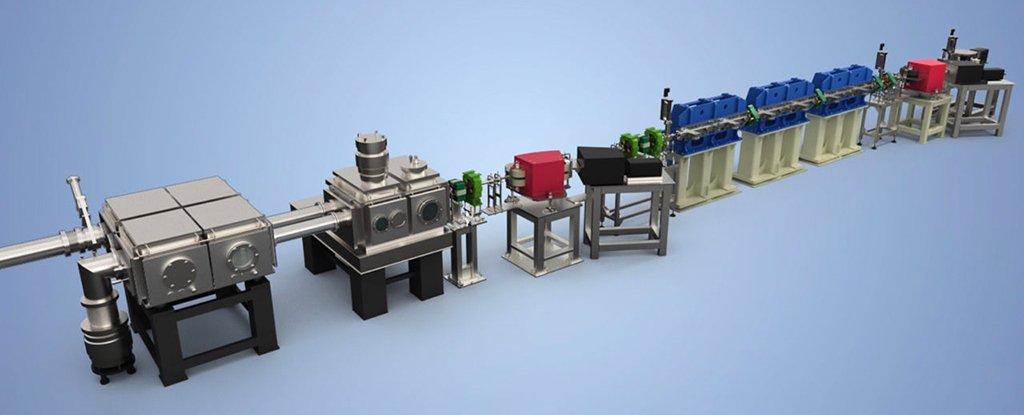Products You May Like
Particle accelerators are hugely important in the study of the matter of the Universe, but the ones we think of tend to be gigantic instruments – surrounding cities in some cases. Now scientists have made a much smaller version to power an advanced laser, a setup that could be just as useful as its larger counterparts.
The particle accelerator in question is a plasma wakefield accelerator, which generates short and intense bursts of electrons, and the laser it’s powering is what’s known as a free-electron laser (FEL), which uses its light to analyze atoms, molecules, and condensed matter in incredibly high resolutions.
While this scenario has been tried before, the resulting laser light hasn’t been intense enough to be useful at smaller scales. Here, the researchers were able to keep the setup enclosed in few normal-sized rooms while amplifying the final electron beam produced by the laser, increasing the intensity by 100 times in the last step of the process.
“We proved the feasibility of the new technical route with the laser electron accelerator with ultra-high acceleration capability, and it downsized the facility size from kilometer level to 12 meters,” says physicist Leng Yuxin, from the Chinese Academy of Sciences (CAS).
There were various challenges for the team in scaling down the technology while also keeping it practically useful. They had to shrink down the variation in the energy of the electrons to just 0.5 percent, for example, which required a series of optimizations that controlled the electron acceleration and ensured smooth travel.
The electrons are fired down a vacuum pipe and through a series of three magnetized undulators, which use their magnetic fields to shake the electrons and produce light. The emitted light pushes back on the electrons, pushing them into smaller groups that then generates the laser beam.
Increasing the electric field through the undulators while maintaining stability is one of the reasons that the setup could be made as compact as it was. It means many of the benefits of particle accelerators can be applied in experiments that are run inside a single room.
“The features of FEL, including its super high-resolution rates regarding time and space and super strong peak brightness, makes it possible to realize three-dimensional, multimodal imaging of matters with ultra-high precision,” says physicist Wang Wentao, from CAS.
Not only is the new setup smaller than your standard particle accelerator and FEL configuration, it’s also much more affordable as well – which opens up all kinds of potential new applications, even if the device isn’t as powerful as the full-scale versions.
Actually getting the new particle accelerator and its FEL ready for practical lab experiments is going to take a lot more time and a lot more research, but the scientists have shown what’s possible in terms of scaling down the whole system.
And while certain questions remain about how well the small accelerator and laser will match up to the results we’re already getting from the bigger versions, other experts have been quick to praise the new research in what it’s managed to do. A lot of new and exciting discoveries could be on the way.
“The application of the potential technology is likely to immensely expand human’s understanding of the mystery of life and the revolution of living things,” says Wentao.
The research has been published in Nature.
